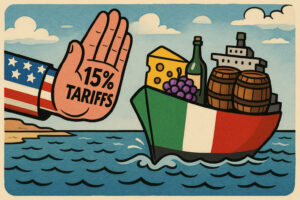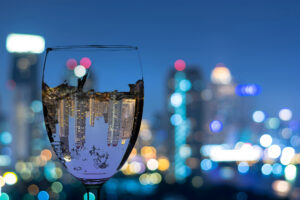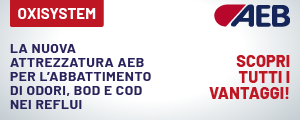The year 2020 has left us with a long trail of disasters, an economic crisis that we need to recover from and a social slash that needs to be mended. But, there is much more. There is a series of changes that will dig a deep gap between the generations, marking a before and an after, which will also affect consumption, including wine, starting in the United States, as the “State of the US Wine Industry 2021” edited by Rob McMillan, founder of the Silicon Valley Bank Wine Division, has revealed. Some of the most important trends, as we said, which will dig the gap between generations, include the enormous number of retired Baby Boomers, the significant growth in working from home, increasingly massive use of home deliveries, the displacement of the population from large cities to residential suburbs, a recession that weighed heavily on low-income employees and the conspicuous growth rate of Internet sales. All of these factors, together with many others as well, must be carefully analyzed before being able to decide on strategic policies to adopt in terms of sales and marketing.
We must start, however, from a premise. The trends that were expected for 2020, and then frozen by Covid-19, are not dead and buried. Before March 2020, the United States’ wine industry was obviously reaching a limit in its growth capacity, primarily due to fundamental challenges that the industry had not fully accepted or entirely addressed. At the end of the day, you cannot correct what you cannot or do not want to see or identify. For instance, let’s take the growth rate of out-of-home wine sales. These sales started turning negative in 2017. In March 2020, though, using only the shelf sales channel, out-of-home sales returned definitely to a positive trend, so much that it prompted the anti- alcohol Associations, upon analyzing Nielsen’s consumption data, to conclude that people tend to drink uncontrollably at home. This is, obviously not the case, and it is even more evident taking into account the closures of bars and restaurants, which have caused, therefore, decreased consumption opportunities. Furthermore, in December, closing restrictions on bars and restaurants became even stricter, which will probably push the final growth rate of wine sales in the United States in 2020 into a window that ranges between 0% and 1%, which is more or less equivalent to the growth of the United States population, (0.6%). Demographics are not lying, and therefore, it follows that consumers have not actually consumed more wine. This, though, is not the right direction to take. Then, how do we recover the growth rates of the past years, which have permitted the wine sector to prosper? We need to start from consumption patterns, which contrast two very different generations, the Millennials, who hold the future in their hands, and the Boomers, who are the actors of the present, but they are in rapid decline. Consequently, while the average age of wine drinkers has continued to rise, the wine world has repeatedly missed the opportunity to grow among younger consumers. The younger wine drinkers have different values; they are more careful about their health; they have lower incomes and less wealth, and they even have different ethnic roots than previous generations. Today, instead, we are experiencing the fall of the target for “mature consumers,” who now average 88.5 years of age. Their number is declining due to the mortality rate, and they now account for only about 5% of consumption in value, and a bit less in volume.
Baby Boomers, though, that have 70% of disposable income and more than 50% of US wealth, are still the largest wine consumers today. Starting this year, however, only one percentage point separates their consumption share from that of Gen X, and they cannot be considered the dominant group anymore. As the latest Silicon Valley Bank reports and demographic patterns have predicted, Boomers are expected to give up their top spot to Generation X precisely in 2021. Boomers are changing their spending patterns, too, due to age, health issues and retirement. While the pandemic has convinced many to retire in 2020, the good news is that many other Boomers will likely continue to work beyond the normal retirement age - usually, on average, at age 66 - and will continue to buy wine.
Generation X, on the other hand, has experienced the two longest economic expansions in the history of the United States. They are still at the height of their purchasing power, and are driving the consumption of various categories, including wine. They cannot, however, boast an even higher rate of growth in consumption, because in 2021 it will be the prerogative of the Millennials, who, therefore, will represent the greatest growth opportunity for the US wine industry. However, this is a generation that is just starting to appear, at a time when growth in volumes purchased is close to zero. If the wine industry wants to experience a season of growth like the one it saw during the period 1994-2014, it must conquer the Millennials, as every wine economy analyst has been saying for years.
According to the “State of the US Wine Industry 2021”, the issue that concerns wine business, today, continues to be the delay with which Millennials are entering the consumption of premium wines. In just another nine years, the latest boomer will be over 66, and will be entitled to all the benefits of social security. At that point, when the Boomers are all retired, what will the average consumer of US wine be like? Millennials are proving to be more and more competitive with Generation X in the low-priced wine consumption quotas. Even though they consider themselves very interested in wine, they had not taken any noticeable steps towards premium wine consumption until the pandemic, and based on research from Silicon Valley Bank, they continue to represent a market share of 17%.
As the wine industry is slowly making its way to attracting the young consumer, the luxury market has gone all in, to use an expression from the poker world, adapting product offerings, digital communication and distribution channel strategies to the target. The comparison with wine business is merciless as roughly 20% of Millennials consume wine, but many more, 33%, buy luxury goods. The growth of Millennials in terms of shares of premium wine consumed, to the detriment of the Boomers, over the years has accumulated a huge delay, for many reasons. First of all, there is a strong preference, which we could define generational, for craft beers and spirits, but there is an increasingly strong demand for healthy consumption as well, and more than anything the delay in economic emancipation and job growth, compared to previous generations.
Furthermore, there is a need for a gear change in communication, which became even clearer in the aftermath of the murder of George Floyd and the protests that followed that tragedy. Young consumers expect more from the brands they consume and support. The Boomers, on the other hand, loved to actually be able to show off their wealth and success. They are the generation that made wine great in America, but talking about wine in a more conscious way, that is, about soils, harvests, pH, winemakers, scores, has allowed the consumer to talk about even the economic value of a bottle of wine, without having to shout it out.
Today, after having experienced a great recession and a pandemic, too, younger wine consumers will not be consumers eager to show off their wealth. They will work towards a better lifestyle, however, and they also want to know that those who have abundant wealth are contributing to building a better world as well. So, instead of bragging about the price, they would rather talk to their friends about how good a wine producer or company is or how well a brand is doing. In addition to issues related to sustainability, health and the environment, which have always been important for the younger generation, today they are equally concerned about issues such as social justice, equity and diversity, which are pushing consumers to exert unprecedented pressure on companies to adopt certain principles and battles. The social link between a brand and the consumer depends more and more on the decision to buy certain goods, including wine. The future success of marketing to Millennials depends on knowing what is important to them versus what is important to boomers. This does not mean changing the appearance of the brand or a traditional label, but rather evolving and exploiting consumer values to market wine. “Wine. It is the drink that young consumers want. They simply do not know it yet”, are the words of Rob McMillan, founder of the Silicon Valley Bank Wine Division and editor of the report, according to which, “it would be easy to start talking about wine in an evolved way, referring to everyday life, to make it a familiar sound even to younger consumers, but as an industry we are not doing that”.
In the wine sector, many people use sustainable agricultural practices and pay close attention to winemaking using recycled water, avoiding the use of glyphosate, working according to the principles of sustainability protocols. Some people use biodynamic and organic farming techniques, but little is seen in the marketing of a bottle of wine today, and none of this appears in the terminology and graphics that the young consumer expects.
Eating healthy is a fundamental value for young consumers. As consumers grow older, it has been widely demonstrated that Boomers are taking the lead from young people, and adopting their own health-conscious diets and consumption patterns. In years gone by, wine has been the only alcoholic beverage that could scientifically demonstrate that it could be part of a healthy diet. This fact is very important, because young consumers are extremely aware of their health, and weight is a factor for living a healthy life. To illustrate a rather fitting example, the best-selling alcohol brand today is Tito’s Vodka, and the best-selling low-calorie drink in US bars is Vodka and soda. How many calories are there in a vodka soda? Sixty. How many calories are there in a glass of wine? Nobody knows, even those who have worked in the industry for years have no idea how many calories there are in a glass of wine. This is exactly what is missing - the transparency consumers demand. Refusing to put calories on the label is a huge deficiency in marketing. If the wine world really wants to reach Millennials, it must look at how other beverages - including soda, energy drinks, hard seltzer, and liqueurs - are being successfully marketed.
Copyright © 2000/2025
Contatti: info@winenews.it
Seguici anche su Twitter: @WineNewsIt
Seguici anche su Facebook: @winenewsit
Questo articolo è tratto dall'archivio di WineNews - Tutti i diritti riservati - Copyright © 2000/2025


























































































































































































